In a recent poll, EKAS asked Australian women to provide a glimpse into the opportunities and challenges they face in 2021. We look through women’s life choices, successes and the pressures experienced by women – within the workplace, their family, the community and within themselves.
Living Happy and Healthy Holistically
Over three quarters (76%) of Australian women surveyed identified that they do in fact feel in good health with a gradual decrease from younger women under 30 (81%) to mature women over the age of 70 (68%). When asked how they were currently feeling in their life considering all aspects the majority of women (72%) declared themselves ‘generally happy’. Those in their 40s were the most likely (33%) to identify as either ‘neither happy nor unhappy’ or ‘generally unhappy’. These women in their 40s identified family (52%) and work/career (53%) as the two highest contributing factors to their unhappiness.
So, what makes a modern woman feel healthy? Well, you are what you eat appears to be true with 85% identifying eating well as a necessary component to feeling good. Social and mental activities seem just as vital, for example, ‘spending time with friends and family’ (74%) and ‘having me time’ (64%). And it seems that ‘doing hobbies that make them happy’ is just as likely to make women feel healthy as their jobs are (50%).
While it seems for women work life is not necessarily a major contributing factor to our overall health or happiness; of working Australian women only half find their job and/or workplace to be a positive impact on their good health, which leaves 1 in 2 Australian women discontented with their nine to five.
Taught to learn, earn and have-it-all
Life as a young woman in Australia is centred on gaining a solid education; with the expectation of finding ourselves in good employment; one that is respectable, successful, and with good pay. We set out on this quest ambitiously, perhaps because of an innate need to prove ourselves.
But how many of us make it to where we imagined our career would take us?
Nothing has thrown the spotlight on women’s abilities to lead and succeed better than the world’s reactions to Covid-19, with many of the top performing countries (in their response to the outbreak) doing so through female leaders. But as women, while we admire and uphold the Jacinda Ardens of our time, perhaps we can’t help but wonder about the sacrifices and hardships it took for them to get there as a woman.
Worldwide political observations aside, we are reminded often that women are still working hard to find equality and satisfaction in the workplace. So, what does the work life of every-day Australian women look like?
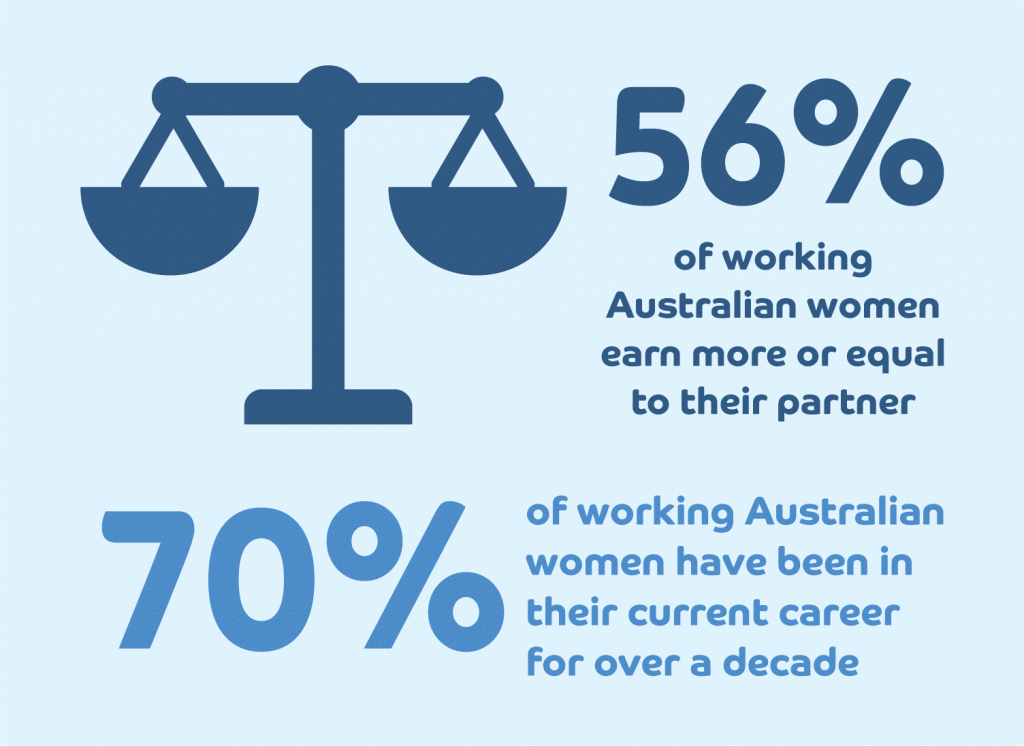
Of the women we surveyed, we found that three quarters are employed, of which 55% are working full-time and 30% are working part-time between 20-30 hours a week. According to the Workplace Gender Agency, 47.1% of all employed persons in Australia are women. While six out of ten women are satisfied with the amount they are currently working, and half are either the highest or equally highest income earner within their household.
Of these working women, 70% have been in their career for over a decade.When they started out in their career, the majority had ambitions to progress into management or even higher (61%). While Australian women are sticking it out in their fields and aiming high, are they reaching their initial goals or reshuffling their dreams? Nearly half (49%) of these women agree their ambitions have since changed, women with children were the most likely to have experienced this change in ambitions, which begs the question is it is it because obstacles proved too many, or because our priorities grow, and we decide there is a different balance to be had?
Reaching for the Top
Perhaps our ambitions to progress our careers came with intentions of finding greater job fulfilment and joy. Unfortunately, at least half of the surveyed ‘ambitious women’ have lost their ambition to reach for the top in their career.
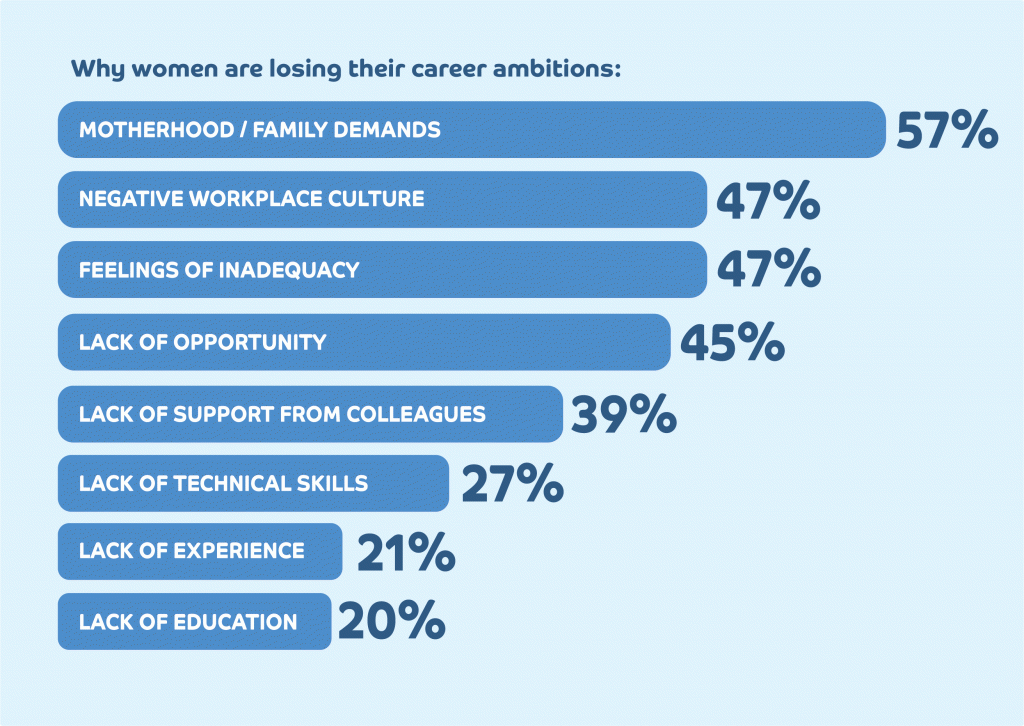
The reasons they gave for this were a little disheartening, with nearly half citing a negative workplace culture (47%), or feelings of inadequacy as causes (47%). Additionally, 45% felt they had lost determination due to lack of opportunity, and 39% from a lack of support from their colleagues. Though given these options, it appears most women do not think the issue is their lack of experience, education or technical skills.
Of the women who said that they had experienced gender bias, the most common setting in which this had occurred was the workplace (80%). Comparatively, the next most common time women felt subjected to gender bias was in a public setting (52%) and less so in other life scenarios.
Australian women are clearly facing some obstacles within their career experiences and pathways. Understandably, we found that women aged 21-30 are far less likely to have lost their determination at work (only 34%), but they are also probably yet to encounter the greatest overall cause women gave to losing their career ambition – motherhood.
Mind the Gap! The Maternity Gap that is…
Gone are the days of the ‘stay-at-home wife or mum’, with only 7% of all women surveyed being currently not employed because they are dedicated to raising children or home duties. Of those who are caring for children, the majority intend to return to work once their children are in day care (47%), and a further 20% once they are in school.
For this small group, the main worries of returning to work are not concerns of facing bias against mothers or a need to upskill. Nor are they concerned about an inability to gain a job of similar level as previously held.
Mostly, they are worried about the difficulty they will face in balancing home life and work life (76%) or finding a job that meets flexibility needs of having children (60%). This sentiment is mimicked by women who have already returned to work since becoming mothers, expressing these same two issues as being the main barriers they faced when they re-entered the workforce.
It appears that for the work/life imbalance that often begins at motherhood, maternity leave and the return-to-work process is rather inconsequential, with the major issue being the ongoing challenges of maintaining ‘maternal duties’ whilst also being career focused. This balancing act, sometimes known as the “woman who has it all”, is still upheld in 2021 by most as being ‘the ideal woman’ (80%).
Working the Second Shift
This ‘second shift’ coined by Hochschild is what working mothers need employers to take into consideration as they take the leap from maternity to returning to the workforce.
Not only are mums contributing to the GDP but also are raising the future generation of Australians and with it comes a lot of pressure. Over half of working mums felt they needed to make a choice between motherhood and putting their career first (53%), and we wonder if their partners experienced such sentiment. Most also said they had struggled (either in the past or currently) with the balance between work and their children (55%).
After ascertaining that motherhood and family demands were the biggest contributing factor for the diminished career ambitions for 57% of Australian women, we delved deeper, finding that the imbalance seems to come from the inability to focus enough of ourselves on our work lives, when we have so much else going on in our heads…
Getting ‘mum guilt’ while at work is one such emotion that is felt by nearly half of working Aussie mothers (48%); the concept of feeling uneasy about not being the traditional ‘stay at home’ mother, not doing enough or the right things as a mother. Returning to work, showing pictures of our newborns to colleagues, we think whether their fathers also get asked if they “feel guilty for leaving those adorable faces”?

The Support Unit
At least with the added guilt laid on, the majority of mums are feeling supported financially by their partner (70%). Unfortunately, emotional support is a little less likely for mothers to be receiving as a constant from their partners, with just 32% feeling they get this from their partner all of the time, and a further 30% stating ‘most of the time’. Fearfully, some 20% stated they do not feel they receive any support in this regard.
In terms of physical hands-on help with the care of their children, only 32% feel supported by their partner all of the time and working mothers are also far more likely than their partners to be solely responsible for most of the household duties; laundry, cooking, cleaning, and groceries. The good news is that most mums feel valued for their contribution to household duties (70%) and for their contribution to household finances (67%), even if those rates are lower than for women without children (79% and 80% respectively).

Cynicism could argue that it may only be driven by legalities, and the spotlight of the public eye, but whatever the cause, it seems that employers in some ways may have come farther than partners in making more women feel supported in motherhood – with 56% of working mothers being able to choose the number of hours that suited them, and over half also feeling supported by their employer to be flexible with work arrangements (53%).
Thirty is the New Twenty
Many women no doubt take all this into consideration when it comes to deciding at what age they want to become mothers, or whether to have children altogether. Our research found that in 10 Australian women, approximately 7 of them are already mothers, 1 is planning to have children in the future, 1 is unsure if they want children or not and the final one has decided that they do not.
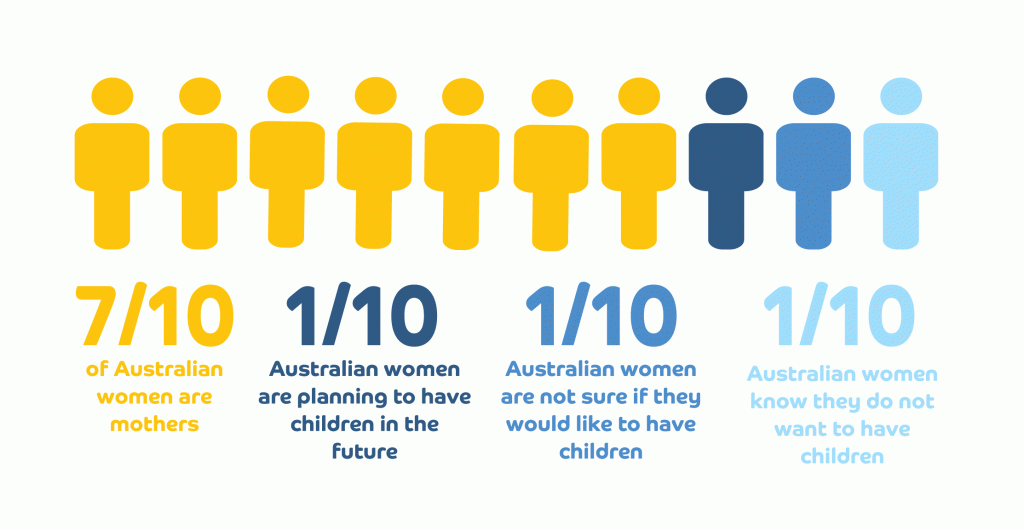
Women in 2021, and indeed for some decades now, have been edging closer to 40 than 20 as their preferred age to have their first child, allowing time to cement their footing in their chosen careers and fulfil their ambitions.
The women surveyed who were already mothers had their first child usually between the ages of 26-30 (31%) or ages 31-40 (29%), and just 2% had their first child over 40. In asking aspiring mothers what their ideal age for starting motherhood would be, the clear preference is 31-40 years old (selected by 60%). Additionally, 5% stated that 41-50 years old would be their ideal.
Then there are the one-in-ten women who have decided they do not wish to have children at all (9%). A choice that has been highly stigmatised in the past, it seems that 47% in this category have found that in 2021 they feel mostly accepted by today’s society on this decision.
Empty Nest, Empty Nest-Egg…
Unsurprisingly, wage disparity (and therefore superannuation disparity) becomes more apparent for mothers, who may take more time off, work less hours, or enter a more flexible (sometimes lower earning) role than their partner.
Of couples with no children, 56% of women are earning equally or more than their partner, whilst in couples with school-aged children only 45% of women are in this position. However, women who live with their partner and their adult child/ren are just as likely to earn equally as women without children (56%). This could imply that gaps or reduction in employment that women experience during the time that they wish to focus on their children, is not necessarily creating a standstill in their career path, but it does create disproportion.
“Due to my time off work to raise the children my super is a lot less than my partners, I also missed out on increasing my career pay, took a pay cut to be more available for the kids, and this reflects in my super balance”
About 41% of women in cis-het relationships with children are concerned about the super disparity between men and women (compared to 34% for cis-het couples without children). This concern becomes more apparent for women as they get closer to retirement age – for women who are partnered and have their adult children living with them, this concern is felt by 52%.
It is an uncomfortable thought that some women are fated financially in retirement simply because they had children or whether they have found themselves in a relationship or not. “It happened to end up not being a problem for me but could have been had I remained single in my latter years” one respondent described.
For some this discrepancy may even be enough to factor into their decision to have children – “It puts me off wanting to have children knowing that financially I will be worse off and might need to depend on a man in the future”.
Wonder Woman – Strong and Invincible…
Workplace bias, societal stigmas, uneven distribution of household duties, the wage gap and superannuation situation aside, the most critical and damaging factor to add to the societal disadvantages of women is domestic abuse or violence, a major issue that Australia in 2021 continues to battle. Of our surveyed women, 30% have personally experienced abuse, with an additional 4% preferring not to answer this question.
Four in ten Australian women have witnessed domestic, sexual, verbal or physical abuse (39%), in which most circumstances the victim was also a woman (83%). These facts are a reminder of the harshness of our reality as modern Australian women, and also a reminder of our resilience despite sufferings. Of those who have been victims of abuse, nearly half have sought support to stop or prevent the abuse (48%).
Having a Strong Mental Game
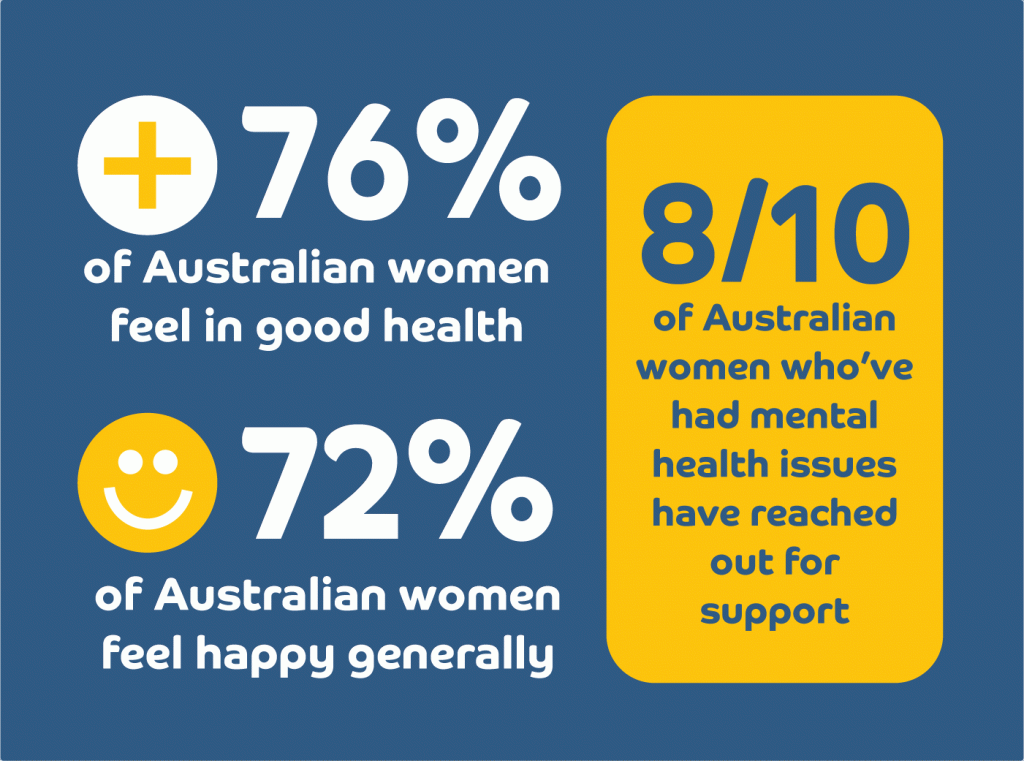
Women are strong and not afraid to know their worth and look after themselves. Overcoming adversity is in us, as while half of women surveyed identified as having mental health concerns, 8 in 10 have reached out for support.
Incredibly, 85% of women who live with mental health concerns found their experience in reaching out for help to be positive. With the positivity in experience coming from mainly the care and assistance offered from the support (82%), as well as how reaching out made them feel (42%) and how family and friends reacted (36%)
Intriguingly, the women who were most likely to have sought out help were the ones who had been detached from a partner, either widowed (99% sought help) or by divorce or separation (90% of these women sought help). In comparison, fewer single women reached out for mental health support when they had issues (80%), and only 77% of partnered/married women.
Aren’t We All Feminists by Now?
The term ‘feminist’ has become somewhat stigmatised over the course of decades, often thought of as purely proactive and advocative rather than to do with personal viewpoints and feelings. The simple yet divisive definition of feminism is the belief in the equal rights of the sexes and so it is to be a feminist.
Perhaps the stigma of being labelled a feminist and without understanding this distinction, more than half of women who participated in this survey did not identify as being modern feminists (55%). In fact, just under a third of women feel that the current feminism has gone too far and is often more about hating or blaming males (31%) and only 40% of women overall can agree that current feminism is about balanced equality.
Of the feminists, around half encourage other women to be aware of feminist issues (51%), but while 27% have feminist values they keep their viewpoints to themselves, perhaps constraint by the aforementioned stigmatism.
Interestingly women who have been through divorce or separation are more likely to identify as feminists than partnered or single women.
2021 and the Modern Australian Woman
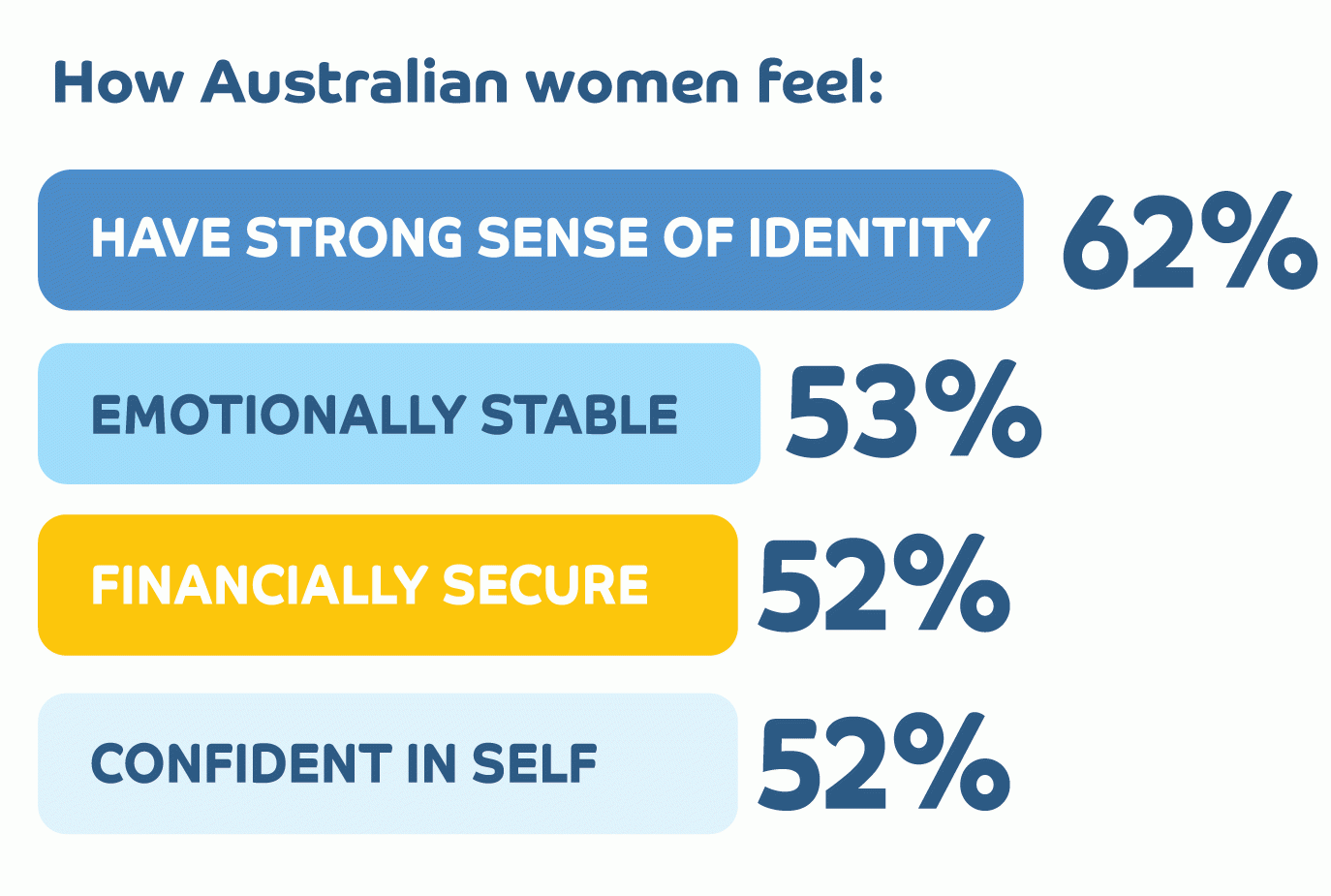
In 2021, as we grow and live as women, often overcoming bias, abuse, and societal expectations that are placed on us from birth – how do we decide to define ourselves? How do we see the ideal woman of our time to be? If not unanimously as feminists, then what else?
Being confident in oneself was the dominant opinion (suggested by 69% of women), followed by having a strong sense of identity (64%). And it seems we do – with 62% of all women believing they hold a strong sense identity, 52% feeling financially secure, 53% feeling emotionally stable and 52% feeling confident in themselves.
What do you believe an ideal woman in 2021 embodies? Is it health, is it strength, is it balance, is it having it all? Here is what some of our members had to say…
“Everyone is different, and it should be that way. A woman is who they want to be and be happy with themselves” Age 51, Queensland.
“Being a woman in 2021 is truly being myself without apology and not conforming to what society thinks I should be or the way I act”. Age 39, New South Wales
“It means different things to different people. For me it means be a good mother, a great friend and financially secure and independent”. Age 48, Victoria
“Well balanced between career and family, confident in yourself to query things” Age 31, Tasmania.
“Being able to be financially secure. Depend upon yourself without the need of a man” Age 53, New South Wales
“It means a different thing to different people and different women”. Age 26, New South Wales
“We are all different and we should be celebrating our diversity”. Age 62, New South Wales
“Challenging old ideas, supporting new ways. Being a friend to yourself. Taking a community focus and lead by example. Set goals for yourself and limits on your sacrifices for others” Age 31, Victoria
“I don’t believe in the ideal woman. We are all different and have different aspirations and ambitions. Nothing or no one is ideal” Age 60, Victoria
“Being a woman in 2021 means being happy with yourself and what you do each day“. Age 24, South Australia
Ekas surveyed 1046 members on it’s panels; Medical Opinion Leaders, Select Opinion Leaders and Apple A Day Research, in February 2021 who identify as a woman.
